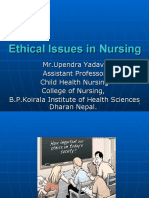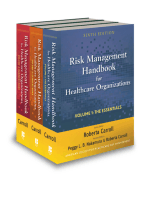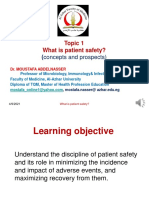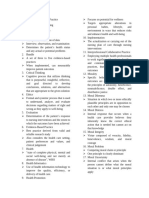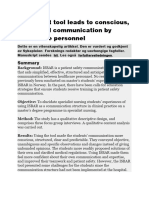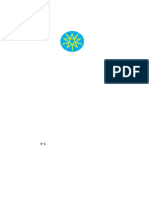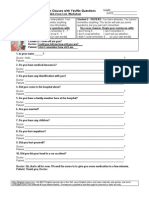100%(1)100% found this document useful (1 vote)
53 viewsPSP MPC Topic-06
PSP MPC Topic-06
Uploaded by
Iqra AnugerahThis document discusses clinical risk management in healthcare. It explains that clinical risk management aims to improve patient safety by identifying circumstances that put patients at risk of harm and preventing those risks. A four-step process to clinical risk management is outlined: identify the risk, assess the frequency and severity, reduce or eliminate the risk, and cost the risk. Learning objectives, knowledge requirements, and performance requirements related to clinical risk management are also summarized.
Copyright:
© All Rights Reserved
Available Formats
Download as PDF, TXT or read online from Scribd
PSP MPC Topic-06
PSP MPC Topic-06
Uploaded by
Iqra Anugerah100%(1)100% found this document useful (1 vote)
53 views13 pagesThis document discusses clinical risk management in healthcare. It explains that clinical risk management aims to improve patient safety by identifying circumstances that put patients at risk of harm and preventing those risks. A four-step process to clinical risk management is outlined: identify the risk, assess the frequency and severity, reduce or eliminate the risk, and cost the risk. Learning objectives, knowledge requirements, and performance requirements related to clinical risk management are also summarized.
Original Description:
Clinical Risk in Healthcare WHO
Original Title
PSP Mpc Topic-06
Copyright
© © All Rights Reserved
Available Formats
PDF, TXT or read online from Scribd
Share this document
Did you find this document useful?
Is this content inappropriate?
This document discusses clinical risk management in healthcare. It explains that clinical risk management aims to improve patient safety by identifying circumstances that put patients at risk of harm and preventing those risks. A four-step process to clinical risk management is outlined: identify the risk, assess the frequency and severity, reduce or eliminate the risk, and cost the risk. Learning objectives, knowledge requirements, and performance requirements related to clinical risk management are also summarized.
Copyright:
© All Rights Reserved
Available Formats
Download as PDF, TXT or read online from Scribd
Download as pdf or txt
100%(1)100% found this document useful (1 vote)
53 views13 pagesPSP MPC Topic-06
PSP MPC Topic-06
Uploaded by
Iqra AnugerahThis document discusses clinical risk management in healthcare. It explains that clinical risk management aims to improve patient safety by identifying circumstances that put patients at risk of harm and preventing those risks. A four-step process to clinical risk management is outlined: identify the risk, assess the frequency and severity, reduce or eliminate the risk, and cost the risk. Learning objectives, knowledge requirements, and performance requirements related to clinical risk management are also summarized.
Copyright:
© All Rights Reserved
Available Formats
Download as PDF, TXT or read online from Scribd
Download as pdf or txt
You are on page 1of 13
Topic 6
Understanding and managing
clinical risk
Patient Safety Curriculum Guide
1
Why clinical risk is relevant to
patient safety
Clinical risk management specifically is concerned with
improving the quality and safety of health-care services
by identifying the circumstances and opportunities that
put patients at risk of harm and acting to prevent or
control those risks
Patient Safety Curriculum Guide
2
Four-step process to clinical risk
management
Identify the risk
Assess the frequency and severity of the risk
Reduce or eliminate the risk
Cost the risk
Patient Safety Curriculum Guide
3
Learning objective
Know how to apply risk-management principles by
identifying, assessing and reporting hazards and
potential risks in the workplace
Patient Safety Curriculum Guide
4
Knowledge requirements
The activities used for gathering information about risk
Fitness-to-practise requirements
Personal accountability for managing clinical risk
Patient Safety Curriculum Guide
5
Performance requirements
Keep accurate and complete health-care records
Participate in meetings to discuss risk management and
patient safety
Respond appropriately to patients and families after an
adverse event
Respond appropriately to complaints
Maintain their own health and well-being
Patient Safety Curriculum Guide
6
Gathering information about risk
Incident monitoring
Sentinel events
The role of complaints in improving care
Complaints and concerns where the individual is
responsible
Coronial Investigations
Patient Safety Curriculum Guide
7
Sentinel events
Unexpected occurrence involving death or serious
physical or psychological injury and including any
process variation for which a recurrence would carry a
significant chance of serious adverse outcome
Source: Joint Commission on Accreditation of Healthcare Organizations, 1999
Patient Safety Curriculum Guide
8
Complaints
Assist in maintaining standards
Reduce the frequency of litigation
Help maintain trust in the profession
Encourage self-assessment
Protect the public
Patient Safety Curriculum Guide
9
Fitness-to-practise requirements
Credentialing
Accreditation
Registration
Patient Safety Curriculum Guide
10
Professional development and self-
assessment
Role of fatigue and fitness to practise
Stress and mental health problems
Work environment and organization
Supervision
Communication
Patient Safety Curriculum Guide
11
How to understand and manage
clinical risks
Know how to report known risks or hazards in the workplace
Keep accurate and complete health-care records
Know when and how to ask for help from an instructor,
supervisor or appropriate senior health-care professional
Participate in meetings that discuss risk management and
patient safety
Respond appropriately to patients and families after an
adverse event
Respond appropriately to complaints
Patient Safety Curriculum Guide
12
Summary
All health-care professionals should:
Be responsible for their patients – not just the seniors
Be personally accountable to prevent harm
Identify areas prone to errors
Work to maintain a safe clinical working environment by
looking after their own health and responding
appropriately to concerns from patients and colleagues
Patient Safety Curriculum Guide
13
You might also like
- Resume For New Graduate NurseDocument8 pagesResume For New Graduate Nurseafiwfrvtf100% (1)
- Production and Operations Management: Massachusetts General Hospital's Pre-Admission Testing Area PATA Case StudyDocument10 pagesProduction and Operations Management: Massachusetts General Hospital's Pre-Admission Testing Area PATA Case StudyJoaquín Norambuena EscalonaNo ratings yet
- Schulz DepositionDocument238 pagesSchulz DepositionMarkingsonCaseNo ratings yet
- GP Entry Guide 2019Document54 pagesGP Entry Guide 2019qamark67100% (1)
- Thesis Final 2Document82 pagesThesis Final 2Aicir Tap100% (1)
- 09topic 06 Understanding and Managing Clinical RiskDocument12 pages09topic 06 Understanding and Managing Clinical RiskMohammed HammedNo ratings yet
- Topic 9 Infection Prevention and Control: Patient Safety Curriculum GuideDocument17 pagesTopic 9 Infection Prevention and Control: Patient Safety Curriculum GuideIndahEkaPutriNo ratings yet
- Patient Safety and Quality Care MovementDocument9 pagesPatient Safety and Quality Care Movementapi-379546477No ratings yet
- 1 - Patient Safety ConceptDocument31 pages1 - Patient Safety ConceptJASON KO CHIA SHENGNo ratings yet
- Risk (Topic 6)Document18 pagesRisk (Topic 6)PIH SHTNo ratings yet
- WA Health Clinical Risk Management GuidelinesDocument46 pagesWA Health Clinical Risk Management GuidelinesRuli Nurul Aman100% (1)
- Dr. Dr. Andry, MM, MH KesDocument50 pagesDr. Dr. Andry, MM, MH KesrohishatulilmiyahNo ratings yet
- Patientsafety (Topic1)Document21 pagesPatientsafety (Topic1)PIH SHTNo ratings yet
- Patient Safety PS 2Document72 pagesPatient Safety PS 2zrjxj6qsjyNo ratings yet
- Introduction To Patient SafetyDocument8 pagesIntroduction To Patient SafetyAshenafi TigabuNo ratings yet
- Module 13b Absconding and Missing PatientsDocument32 pagesModule 13b Absconding and Missing Patientshatem newishyNo ratings yet
- A Blueprint For Action 240619Document98 pagesA Blueprint For Action 240619abdu misbahNo ratings yet
- Ebook A Guide To Improving Your Patient Safety Event Reporting Culture Plus A Leadership Action ListDocument8 pagesEbook A Guide To Improving Your Patient Safety Event Reporting Culture Plus A Leadership Action ListJery JsNo ratings yet
- Patient Safety and Managing Risk in NursingDocument28 pagesPatient Safety and Managing Risk in NursingIonela UngureanuNo ratings yet
- Chess Bookletfinal2011Document47 pagesChess Bookletfinal2011Sugam GouliNo ratings yet
- Konsep Pasien Safety Dalam Keperawatan, DR AdibDocument32 pagesKonsep Pasien Safety Dalam Keperawatan, DR Adibvhero handayaniNo ratings yet
- Clinical Risk Management in Newborn and Neonatal ResuscitationDocument17 pagesClinical Risk Management in Newborn and Neonatal ResuscitationRaja SekarNo ratings yet
- Geria (Midterms)Document42 pagesGeria (Midterms)ANGELA GLORIA LAPUZNo ratings yet
- Safe Patient HandlingDocument41 pagesSafe Patient HandlingRevalina NurazizahNo ratings yet
- How Can Leaders Influence ASafety CultureDocument11 pagesHow Can Leaders Influence ASafety CultureGustavo Tapia AvendañoNo ratings yet
- Ethical Issues in NursingDocument30 pagesEthical Issues in NursingUpendra Yadav100% (2)
- Patient Safety: What About The Patient?: Consumers' ViewDocument5 pagesPatient Safety: What About The Patient?: Consumers' Viewujangketul62No ratings yet
- Patient Safety Is A Key Component of Risk Management - Dr. Adib A YahyaDocument60 pagesPatient Safety Is A Key Component of Risk Management - Dr. Adib A YahyaDINA WULANDARINo ratings yet
- 2012PatientSafetyCulture of SafetyDocument13 pages2012PatientSafetyCulture of SafetyRAHMAHNo ratings yet
- 1a. Introduction To Critical CareDocument34 pages1a. Introduction To Critical CareMaryam saleemNo ratings yet
- Risk Management Handbook for Health Care Organizations, 3 Volume SetFrom EverandRisk Management Handbook for Health Care Organizations, 3 Volume SetNo ratings yet
- 118 - Week 2Document35 pages118 - Week 2Ma. Kristina Cazandra IbañezNo ratings yet
- Who MC Topic-6Document14 pagesWho MC Topic-6Kartika Radianti WardhaniNo ratings yet
- s9 Basic Life SupportDocument27 pagess9 Basic Life SupportputuNo ratings yet
- Nursing ProcessDocument62 pagesNursing ProcessplethoraldorkNo ratings yet
- Healthcare Assistant - JDDocument5 pagesHealthcare Assistant - JDM LubisNo ratings yet
- Nursing ProcessDocument62 pagesNursing ProcessMara MaraNo ratings yet
- Safety Presentation 2Document9 pagesSafety Presentation 2api-324886317No ratings yet
- Sefety and InjuryDocument24 pagesSefety and Injuryswing.sujuNo ratings yet
- PS Is A Key Component of RM (DR - Adib)Document46 pagesPS Is A Key Component of RM (DR - Adib)edi edongNo ratings yet
- Clinical Practice at North Shore-Long Island Jewish Health SystemDocument55 pagesClinical Practice at North Shore-Long Island Jewish Health SystemRuslan ShyyanNo ratings yet
- MM20802-EPID IN CLINICAL PRACTICE Y2.v2Document18 pagesMM20802-EPID IN CLINICAL PRACTICE Y2.v2danishNo ratings yet
- Part FiveDocument8 pagesPart Fiveramoyakevin5No ratings yet
- Concepts of Quality, Patient Safety and Risk ManagementDocument40 pagesConcepts of Quality, Patient Safety and Risk ManagementOmarShurafaNo ratings yet
- Public Service Announcement On Personal Safety (AutoRecovered)Document4 pagesPublic Service Announcement On Personal Safety (AutoRecovered)Abel MkhizeNo ratings yet
- Global Patient Safety Action Plan 2021 2030 - Third Draft - January 2021 - WebDocument109 pagesGlobal Patient Safety Action Plan 2021 2030 - Third Draft - January 2021 - WebJosianeAzolinNo ratings yet
- LAS 5Document17 pagesLAS 5Dawn HuangNo ratings yet
- Tugas Kebijakan Keselamatan PasienDocument8 pagesTugas Kebijakan Keselamatan PasienJessica GraciaNo ratings yet
- 1.what Is Patient SafetyDocument27 pages1.what Is Patient Safetyhum JavedNo ratings yet
- 1st Year Evaluation Tool E-ValueDocument3 pages1st Year Evaluation Tool E-ValueTulaNo ratings yet
- Dr. Aidah Abu Elsoud Alkaissi Devision of Intensive Care and Anesthesiology University of Linköping-SwedenDocument43 pagesDr. Aidah Abu Elsoud Alkaissi Devision of Intensive Care and Anesthesiology University of Linköping-SwedenTarsis HenitaNo ratings yet
- Warm-Up Activity Categories ResponsesDocument2 pagesWarm-Up Activity Categories ResponsesEnzo DyNo ratings yet
- Topic 1 What Is Patient Safety?: (Concepts and Prospects)Document21 pagesTopic 1 What Is Patient Safety?: (Concepts and Prospects)Reda ZizoNo ratings yet
- Fundamental of Nursing TheoryDocument145 pagesFundamental of Nursing Theoryash90zxcvbnmNo ratings yet
- The Nursing Process: Dr. Abdalkarim RadwanDocument62 pagesThe Nursing Process: Dr. Abdalkarim RadwanAngelique Ramos PascuaNo ratings yet
- Concepts, Process, and Practice Kozier & Erb's 9 Edition: Fundamentals of NursingDocument7 pagesConcepts, Process, and Practice Kozier & Erb's 9 Edition: Fundamentals of NursingLester Paul SivilaNo ratings yet
- Unit 1 - MSDocument10 pagesUnit 1 - MSLei NepomucenoNo ratings yet
- Fundamentals of Nursing : The Art and Science of Person-Centered Care 9th Edition Carol Taylor 2024 scribd downloadDocument37 pagesFundamentals of Nursing : The Art and Science of Person-Centered Care 9th Edition Carol Taylor 2024 scribd downloadhavigscace9n100% (2)
- General Course Guide: Islamic City of Marawi, Lanao Del SurDocument8 pagesGeneral Course Guide: Islamic City of Marawi, Lanao Del SurSitty Aizah MangotaraNo ratings yet
- Breast Cancer Content Concepts Map For Case Study1Document3 pagesBreast Cancer Content Concepts Map For Case Study1akankshaNo ratings yet
- Breast Cancer Content Concepts Map For Case Study1 PDFDocument3 pagesBreast Cancer Content Concepts Map For Case Study1 PDFakankshaNo ratings yet
- Pink Rose Watercolor Organic Creative Project Presentation 20240507 231426 0000Document11 pagesPink Rose Watercolor Organic Creative Project Presentation 20240507 231426 0000Margarita OrlinaNo ratings yet
- Veterinary Clinics: Effective Communication in Veterinary PracticeDocument4 pagesVeterinary Clinics: Effective Communication in Veterinary PracticeIlyas ZargarNo ratings yet
- Topic 11 Improving Medication Safety: Patient Safety Curriculum GuideDocument55 pagesTopic 11 Improving Medication Safety: Patient Safety Curriculum GuideErnda PutrNo ratings yet
- Effect Sugar On ChildrenDocument5 pagesEffect Sugar On ChildrenIqra AnugerahNo ratings yet
- Trichomoniasis and Bacterial Vaginosis in Pregnancy: Inadequately Managed With The Syndromic ApproachDocument10 pagesTrichomoniasis and Bacterial Vaginosis in Pregnancy: Inadequately Managed With The Syndromic ApproachIqra AnugerahNo ratings yet
- The Syndromic Management of Vaginal Discharge Using Single-Dose Treatments: A Randomized Controlled Trial in West AfricaDocument10 pagesThe Syndromic Management of Vaginal Discharge Using Single-Dose Treatments: A Randomized Controlled Trial in West AfricaIqra AnugerahNo ratings yet
- Laparoscopic Removal of Translocated Retroperitoneal IUD: K.K. Roy, N. Banerjee, A. SinhaDocument3 pagesLaparoscopic Removal of Translocated Retroperitoneal IUD: K.K. Roy, N. Banerjee, A. SinhaIqra AnugerahNo ratings yet
- Brown - 2014 - Endometriosis - An Overview of Cochrane Reviews (Review)Document44 pagesBrown - 2014 - Endometriosis - An Overview of Cochrane Reviews (Review)Iqra AnugerahNo ratings yet
- Technical Update On Physiology Amniotic FluidDocument7 pagesTechnical Update On Physiology Amniotic FluidIqra AnugerahNo ratings yet
- Guideline On The Management of Anogenita WartsDocument9 pagesGuideline On The Management of Anogenita WartsIqra AnugerahNo ratings yet
- ISBARDocument44 pagesISBARabhibishnuNo ratings yet
- Resume RN GradDocument3 pagesResume RN Gradapi-508609843100% (1)
- 2023 HCPDocument17 pages2023 HCPNamira AliNo ratings yet
- Patient Wellbeing Assessment and Recovery Plan - Children and AdolescentsDocument12 pagesPatient Wellbeing Assessment and Recovery Plan - Children and AdolescentsSyedaNo ratings yet
- 416-JNR082 - Clinical Fellow Rotational Post Job Description & Pers SpecDocument16 pages416-JNR082 - Clinical Fellow Rotational Post Job Description & Pers SpecAbu Hurraira KhanNo ratings yet
- SB 530 531Document10 pagesSB 530 531WWMTNo ratings yet
- 4a - Patient Registration FormDocument7 pages4a - Patient Registration FormHygiena Kumala SuciNo ratings yet
- Handout On Role of Nurse On Nutritional RequirmentsDocument4 pagesHandout On Role of Nurse On Nutritional RequirmentsBeulah DasariNo ratings yet
- History Taking: Ma. Sheila Blossom B. Bo RM, RN, MmeDocument14 pagesHistory Taking: Ma. Sheila Blossom B. Bo RM, RN, Mmejhayrus pletaNo ratings yet
- EBPDocument7 pagesEBPMahreen UmatiyaNo ratings yet
- Hca 468 PaperDocument9 pagesHca 468 Paperapi-487927401No ratings yet
- Assessment of PWD Checklist Rev 7-19-17Document2 pagesAssessment of PWD Checklist Rev 7-19-17riddhiNo ratings yet
- Second Year Anesthesia ESSTM Saoussen JilaniDocument11 pagesSecond Year Anesthesia ESSTM Saoussen JilaniPrettyFarahNo ratings yet
- 揽瓜阁逻辑做题小分队合辑volume2Document119 pages揽瓜阁逻辑做题小分队合辑volume2Edward WangNo ratings yet
- International Patient Safety Goals IPSGDocument20 pagesInternational Patient Safety Goals IPSGShafique HussainNo ratings yet
- DTC PMDocument201 pagesDTC PMmulunash5052No ratings yet
- English For Nurse Anesthetists in Indonesia The NeDocument11 pagesEnglish For Nurse Anesthetists in Indonesia The NeDJ MAATNo ratings yet
- AmnesiaDocument2 pagesAmnesiachoc2489No ratings yet
- XyrichisReam Teamwork Sep2007 PDFDocument12 pagesXyrichisReam Teamwork Sep2007 PDFAnonymous zNLHsubo1No ratings yet
- The David H. Koch Center For Cancer Care Memorial Sloan Kettering Cancer CenterDocument5 pagesThe David H. Koch Center For Cancer Care Memorial Sloan Kettering Cancer CenterdnmNo ratings yet
- Fundamentals of Nursing Peacock College of Nursing Akure Unit 1Document22 pagesFundamentals of Nursing Peacock College of Nursing Akure Unit 1dadawonderful345No ratings yet
- United Healthcare CA Select Plus Silver 30 2000 30 Aksa W 405Document8 pagesUnited Healthcare CA Select Plus Silver 30 2000 30 Aksa W 405zxcvNo ratings yet
- Hospital Operations Management and Gandhian IdealsDocument8 pagesHospital Operations Management and Gandhian Idealsanksri07No ratings yet
- Date/ Time Focus DAR: Disturbed Thought ProcessDocument1 pageDate/ Time Focus DAR: Disturbed Thought ProcessMaria Chrislyn Marcos GenorgaNo ratings yet
- Kolkatta RG Kar Rape and Murder Case - Supreme Court Order Dated 20 August 2024Document16 pagesKolkatta RG Kar Rape and Murder Case - Supreme Court Order Dated 20 August 2024Suresh NNo ratings yet

























